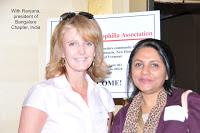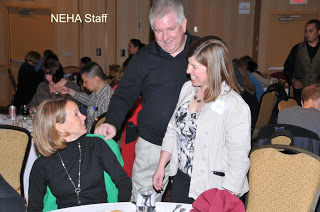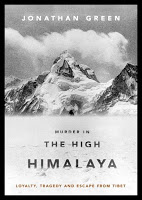995
 I happily drove an hour to Westwood, Massachusetts to attend the New England Hemophilia Association’s Springfest, a gathering of local hemophilia families and the companies and medical people who serve them. It was a glorious, sunny day and a wonderful event.
I happily drove an hour to Westwood, Massachusetts to attend the New England Hemophilia Association’s Springfest, a gathering of local hemophilia families and the companies and medical people who serve them. It was a glorious, sunny day and a wonderful event.Val Bias, CEO of NHF, attended to present an overview of NHF’s programs and also how funding is raised and where it is spent. Here are some stats:
• There are 57 full time and part time staff at NHF over 10 states
• There are 8 regions for HTCs now, down from 12
• NHF has a PDF you can download called “50 Steps to Cultivating Donors”
• 50% of the NHF’s board of directors are not related to hemophilia
• 52% of its budget comes from pharma
Val stressed to the audience to get involved locally, and to consider joining the NEHA board. He made a compelling plea and is an excellent speaker. Many people told me later they thought Val is a gifted presenter and a wonderful leader for our community.
Next up was a great presentation on gene therapy and new products coming soon by Dr. Ellis Neufeld of the Boston Hemophilia Center. Dr. Neufeld did an amazing job of taking highly complex material and breaking it down for us. Some highlights:
• The St. Jude gene therapy trial that has been in the news: only 6 FIX patients in trial, using “gutted” virus (no capacity to reproduce).
• Of 6, only 1 really took to it but he got higher ALT (liver
function measurement).
function measurement).
• Problems with the study: not enough data, immune response a threat and you can’t be retreated
as you will have an immune response.
as you will have an immune response.
• Long acting factor: many companies working on this. Everyone has different half-lives; children have shorter
ones than adults. So how long is long? New FIX drugs could be 3-5 times longer acting, meaning you might treat once every 10-14 days?
ones than adults. So how long is long? New FIX drugs could be 3-5 times longer acting, meaning you might treat once every 10-14 days?
• What will price be of the longer acting drugs? What is the worth for a theoretical improvement of
life? No one yet knows.
life? No one yet knows.
(Our next issue of PEN in May examines all these in depth: be sure to download it!)
Dr. Neufeld was very positive about current gene therapy efforts. He made us all laugh by saying that our community has been promising us gene therapy roughly in every ten year cycles, but this time, he truly feels there is a great chance we will find it.
Just before lunch, we had panel presentations from all the pharma and specialty pharmacy reps on their patient assistance programs, delivered all above the growing din from the Bar Mitzvah next door!
 These were all great presentations, and we had an attentive audience. I saw so many of my friends in hemophilia, and truly enjoyed myself. I hope you can all attend a local hemophilia event and take part in your community! We had a rap session with the moms, and one among us had an 8 month old. We all remember the feelings of when our babies were diagnosed. We felt for her. Everyone rushed to welcome her, praised her for attending, and offered email addresses and phone numbers. It never fails to amaze me how tight our community is. We are friends, and family, for life.
These were all great presentations, and we had an attentive audience. I saw so many of my friends in hemophilia, and truly enjoyed myself. I hope you can all attend a local hemophilia event and take part in your community! We had a rap session with the moms, and one among us had an 8 month old. We all remember the feelings of when our babies were diagnosed. We felt for her. Everyone rushed to welcome her, praised her for attending, and offered email addresses and phone numbers. It never fails to amaze me how tight our community is. We are friends, and family, for life.by Jonathan Green
This is a rare book that provides multiple levels of reading, on history, ethics, exposé, culture, politics and an unforgettable story of a young girl’s perseverance, determination and tragic legacy. I love real life adventure and survival books, especially about mountain climbing and/or history, and also books about how one person can change the world. This book has it all. On September 30, 2006 a cruel and thoughtless murder of a 17-year-old Tibetan nun (just a girl truly) by Chinese border guards triggered an avalanche of scrutiny in the press, world agencies, political leaders–and in the consciences of the Western mountain climbers on a paid guided climb who watched in horror. Kelsang Namtso was trying to escape Tibet via the mountain Cho Oyu when she was gunned down in full view of climbers, one of whom videotaped it. The tape went viral—the first time human rights violations against the Tibetans had been filmed—and the rest is history. This book tells this amazing story in gripping and often exquisite prose (much like Jon Krakauer) and provides powerful parallel stories of Kelsang and the mountain climbers, which later intersect dramatically and make history (much like author Erik Larsen). You will be amazed at the courage of this 17-year-old, and at the response by those who witnessed her death. Green’s compelling narrative will teach you much about Tibet, how it has suffered under Chinese rule, and how the West has looked away until one lone video clip, still available on YouTube, shamed us into action. Green raises excellent questions that beg an inward look at our own souls, and portrays Tibetan lives without freedom that make us instantly cherish our own freedom. A must read. Four out of five stars.





